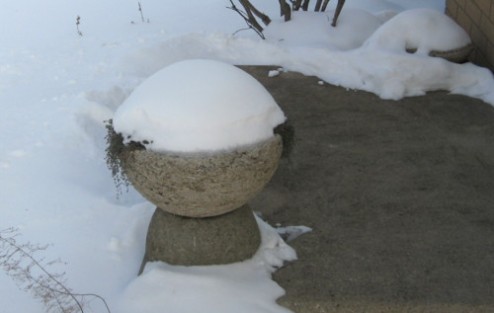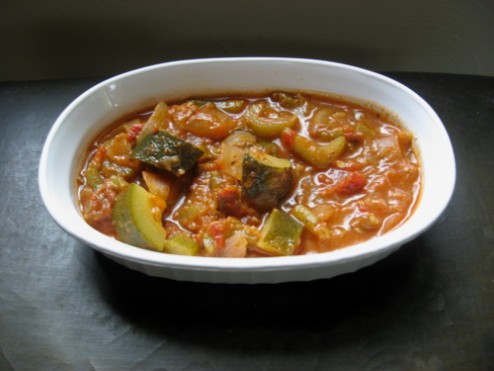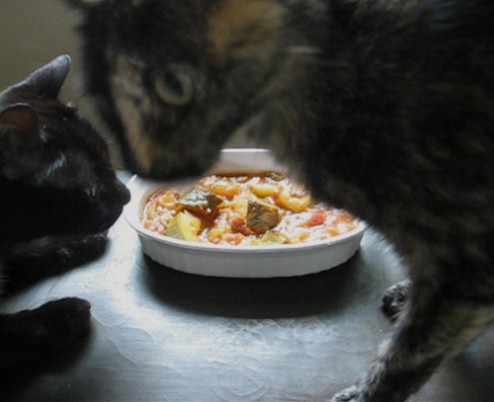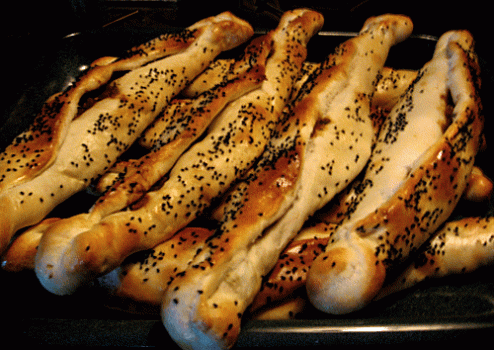Chickpeas and Panir with Tomatoes and Garlic
The last few days I’ve been “laid up” with a back injury- nothing too serious- just a few strained muscles, and I am doing pretty well right now. But, during that time, I needed something fairly quick and easy to make as a main protein source, so I thought of making an old Jaffrey standby: chickpeas and potatoes in tomato and garlic sauce. It has no long onion-bhuno-ing step; instead, a massive amount of garlic paste is fried in oil, tomatoes are added and slowly simmered…(well, at least it’s an easier bhuno-ing that didn’t require me to stand for too long!), and then a fairly brief cooking of the sauce with the chickpeas. Instead of potatoes, I thought of using panir as I had pre-fried a home-made batch of it a day or two before my injury and tucked it away in the fridge. The rest I did in parts as I could tolerate it- but I must confess to you that I ended up reclining on the floor to peel the garlic!
Since I was a little bit in want of fun, I decided not to follow the rest of that original recipe exactly; instead, I took a cue from one of my favorite bloggers- the famous Musical and her equally famous Kitchen. Musical is always playing around with new ingredient combinations and trusting her instincts to concoct interesting mixes of spices- all the while managing to create some really delicious dishes. So I thought “why not?” and took her cooking-is-as-easy-as-breathing approach, and, amazingly, my experiment turned out! It tasted so good that I decided to share it with y’all… and especially this is for other garlic-tomato-chile combo lovers out there! (You know who you are!)
Chickpeas and Panir with Tomatoes and Garlic
2 C dried white chickpeas/ kabuli chana
3 T oil/ghee
1 t cumin seeds
pinch of hing
18-24 cloves of garlic, pasted- about 3 T
2 C tomato puree
2 t coriander seeds (dry-roasted)
1 t cumin seeds (dry-roasted)
1 t ground red chiles, or to taste
1/2 t turmeric
1 1/2 t amchoor (or lime juice to taste)
2-3 C panir cubes, lightly fried in oil and drained
2 t kasoori methi, finger-crushed
6 green chiles (I used serranos), sliced into 1/8″ rounds (de-seed if you prefer it milder)
3 C broth from the cooked beans
salt to taste
1)Rinse chickpeas well, then cover in plenty of water to soak 12 hours; drain, then add fresh water to cover by an inch or two and cook for 5 minutes at 15 lbs. in a pressure-cooker, allowing pressure to fall on its own and cool- or simmer in enough water to cover until tender. Drain, reserving 3 C of broth.
2)Dry-roast coriander seeds and 1 t of cumin seeds until medium-brown; cool, and grind to a powder.
3)Heat oil or ghee over med-low, add the remaining teaspoon of cumin seeds, fry for a few seconds, then add the hing, followed by the garlic paste; fry, stirring continuously until the raw smell disappears (keep your face away actually!)- about 2-3 minutes, until garlic is a pale brown and has lost most of its moisture.
4)Add the tomato puree, stir well and slowly fry, stirring occasionally at first and more frequently as it reduces, until the oil returns and appears at the edges.
5)Add the dry-roasted spices, turmeric, ground chiles, and amchoor; fry for about 2 minutes more.
6)Add the cooked chickpeas, panir, kasoori methi, sliced chiles, and reserved broth; mix gently, bring slowly to a simmer and allow to cook uncovered for 30 minutes or so, stirring occasionally; add salt to taste. Serve with any flat-bread of choice- para(n)thas are always good. 😀 But I was feeling perky today so I made pooris; I was thrilled because they all puffed up like balloons and one of them was actually round! 🙂
(clockwise: chickpeas and panir…, bitter melon stir-fried…, a round poori, homemade karela ka achaar, Bihari-style saag/pureed green stuff)
Stewed Zucchini with Tomatoes
A little while back, Musical posted an intriguing Punjabi “rural” recipe. I made it, and found that the final dish, plus her written introduction to the recipe, reminded me very much of another dish that my own maternal grandmother would often make, especially if she knew that I was coming to visit as she was well aware that I loved it so: stewed zucchini.
I don’t know too much about this dish’s history, but I can tell you that it is very popular here in the midwestern area of the U.S.; I would think it was introduced in the early 1900’s when there were many Italian immigrants settling in the area, but this is pure speculation on my part… and, although there are a few vegetable-canning companies that produce a simple and bland version of this dish, thankfully I never tasted them while I was growing up. My German grandmother always prepared it fresh with ingredients from her large garden.
Just short of 5 feet tall, she was a brilliant lady with a quiet, determined energy, who seldom followed recipes nor wrote down her own. Therefore, she had little to pass on to future cooks in the family unless you happened to be present during the heyday of her busy kitchen with an interest and a watchful eye, tasting and asking questions. Her spicing/herbing had a tendency to change with her moods, but I can tell you for certain that, in this dish, she always included garlic and a smidge of ground chiles- not too much, because grandpa would complain… but as much as she could get away with!
This is my own recipe….er, well, I should say that this was the way I made it a few days ago! I usually don’t think about it and just hum along while I add this and that to taste, but this time I wrote it down! And I must say it’s the best I’ve ever made.
Other summer squashes/young gourds can be used in place of zucchini; in fact, my grandmother usually made it using half dark-green zucchini and half yellow crooknecks for a nice colour combo.
Stewed Zucchini with Tomatoes
4 T olive oil
1 T butter*
3 T garlic paste
2 lg. onions, diced 1/2″
2-3 stalks of celery, sliced crosswise 1/4″
1 C of mixed green chiles and/or capsicums(bell peppers), seeded and diced 1/2″ (I used seeded serranos)
1/4 t or more of ground red chiles (I used 1 t)
1 1/2 t fresh thyme leaves (or 1 t dried)
4 fresh basil leaves, minced (or 1/2 t dried)
A few leaves of fresh oregano (1/2 t dried)
3-4 fresh spearmint leaves (1/4 t dried)
A few grinds of black pepper
A teensy-weensy, little-itty-bitty pinch (use your two pinky-fingers to do this) of ground allspice berries
3 1/2-4 C peeled and roughly-chopped fresh tomatoes (good-quality canned or home-canned works fine too)
salt to taste
2 medium-sized or 3-4 small zucchini, quartered lengthwise and sliced 3/4″
1 C fresh green beans, chopped 3/4″ or other mild-flavoured green vegetable of your choice (chopped spinach or other greens work well)**
1/4 C pickled/brined capers
1)Eighteen ingredients…it sounds daunting, but it’s not- easy easy! Warm the oil and butter over med-low heat, add the garlic paste and saute for about 30 seconds.
2)Add the onions, celery and green peppers, raise the heat to med-high and saute until the onions turn translucent.
3)Add the aromatics, and stir, frying for about 1 minute.
4)Add the tomatoes and some salt; keep stirring until the juices are released- about 3-4 minutes.
5)Add the zucchini, green beans, and capers; stir well. Add a half-glass of water, if necessary, to bring the liquid nearer the top of the veggies, and bring to boil. Cover, lower heat way down and simmer for 30 minutes, stirring now and then.
6)Adjust salt and grind a bit more black pepper on top. Serve with bread, over pasta or with rice.
*If you would like to serve this as a chilled soup, replace the butter with more olive oil; thin the stew with more water.
**Some people like to add ground meat or sliced sausages, browning it at the beginning with the garlic (reduce oil, omit butter), but my grandmother usually made it meatless, and often added small amounts of other seasonal vegetables. Just remember: the zucchini must be the star in this show! 🙂
Curious contenders for the starring role: Kalonji and Washiarla…
A few people have mentioned the dish’s similarity to the French ratatouille. I did some reading in Wikipedia, and found that there are several, similar dishes across Europe: kapunata– Malta, caponata– Italy, pisto– Spain, lesco– Hungary, letscho– Germany… Though many of these are prepared with eggplant, there was mention of variants using zucchini or other summer squashes/young gourds.
These dishes, in turn, seem to repeat the much-loved combination of eggplant with tomatoes found throughout the Middle East and eastern Mediterranean, again with variants sometimes using young gourds instead of eggplant, apparantly descended from the Arabian musaqqaʿa…
Pide with a savoury filling of tomatoes, brinjals, and capsicums
The story goes like this: Three elegantly-dressed ladies: A Marathi, a Malayali, and a Konkani from Karnataka, sashay into a Turkish restaurant together and politely request of the chef to prepare something that all of them would like. After summoning his only waiter to their side, he takes a moment to ponder the task set before him, and then begins to work in his kitchen. Little do they know he isn’t really a Turk…but he has dabbled enough in the cuisine to be open for lunch now and then; today is their lucky day it seems…. a short time later, after they’ve serenely polished off a few cool drinks while waiting, the chef returns, grinning from ear to ear. With just a hint of smugness, he sets down a platter of steaming and fragrant…………
Well, you probably know the rest of the tale. This story is as old as the hills!
One of these and a few small sides can make for a wonderful lunch, or serve with cocktails or at tea-time, cut across into 1″ slices for beautiful dainty finger food. As they are bread-and-side-dish in one, these are excellent to take on picnics or outings of any kind for a convenient meal.
It is almost necessary to have a baking tile or tiles or “pizza stone” set on the middle position rack of your oven for these to be successful. (see note) The filling for this can be made a day or two in advance. In fact it is somewhat better to do so, allowing the complex flavours to blend quite harmoniously.
Pide with a savoury filling of tomatoes, brinjals, and capsicums
For the filling:
6-8 small brinjals(about 3 cups), tops removed, halved, and sliced to 1/4″
1 1/2 t salt
1 1/2 T oil
1/2 C besan
2-3 t oil
a pinch of asafoetida
3/4 t black mustard seeds
1/2 t cumin seeds
1 t fenugreek seeds
6 curry leaves, chopped
2 t ground red chiles
1/2 t turmeric
1/4 t ground black pepper
2 C mild or sweet capsicums(such as bell, poblanos, new mexico, california), chopped to 1/2″
2 C tomatoes, skinned and chopped fresh or canned
2 fresh green chiles, seeded and sliced thinly
8 cloves of garlic, minced or pasted
1/2 C water
3/4 t salt (or to taste)
2/3 C finely-chopped coriander leaves
1)Sprinkle the brinjal slices with salt in a bowl, mix well, and let stand for an hour. Drain off the liquid that accumulates and rinse three times. Squeeze out as much water as possible with your hands or by using a piece of cheesecloth. Heat 1 1/2 T oil in a pan and fry the slices until nicely browned and somewhat dry. Remove these to a dish lined with cloth or paper to cool and drain the excess oil. Chop roughly and set aside.
2)In a pan set over medium-low heat, roast the besan until fragrant and a shade darker. Set aside.
3)Heat 1 1/2 t oil in a wok or karahi. Add the hing, a second later add the mustard seeds, cumin seeds, and fenugreek seeds. When the mustard seeds pop, add the curry leaves and ground spices. Stir once or twice and then add the capsicum, tomatoes and chiles. (mind the spluttering)
4)Cook this mixture over low heat, stirring occasionally at first and more frequently as the mixture reduces, until the oil appears at the edges and it has formed a paste. Turn heat to low.
5)Add the brinjals and garlic and continue to fry, stirring constantly, for 4 more minutes.
6)Add the water and salt to taste and mix well. Add the roasted besan and mix until well-combined. You should have a thick paste now. Add the coriander leaves and remove from heat.
Making the pide:
1 T active dry yeast
1/2 t sugar
1/2 C warm( not hot) water
1/2 C all-purpose flour
3 1/2 C bread flour
1 t salt
3 T oil
1 C plus 1 T lukewarm water
filling from above
1 egg, lightly beaten
kalonji seeds
1)Dissolve the yeast and sugar in warm water let stand in a warm place for 10 minutes. It should have bubbles. Stir in the A-P flour, cover with plastic and let rise 30 minutes.
2)Place the bread flour in a large bowl; make a well in the center and pour in the yeast mixture, salt, oil, and lukewarm water. Gradually work the flour into the contents of the well to form a dough. Take this dough and knead it on a floured surface for 15 minutes until it is smooth and elastic, and no longer sticks to your hands. Add more flour if necessary and continue kneading until the dough no longer is sticky.
3)Oil the large bowl and place the dough back into it; cover with plastic and let rise 1 hour.
4)Take the dough out and divide it into 8 equal pieces. Roll each piece into a ball, place on a floured sheet or tray and cover with a damp towel. Set aside for 30 minutes.
5)Preheat oven with tiles at 500-550 F for 30 minutes before you bake.
6)Take each ball and roll out roughly to a 6″ X 12″ oval on an oiled board. Divide the filling into 8 parts and place a portion on each oval. Spread the filling, keeping 1/2″ away from the edges. Fold the two long sides of the dough over the filling, the edges overlapping along the center. Press down on the folded edges a bit. At the ends, pinch together 1″ from each side to seal. Brush the tops with beaten egg, sprinkle with kalonji seeds.
7)Place one or two pide on the hot tiles at a time and bake 6 minutes, until golden. Keep the finished pide wrapped in a dry towel to stay warm while you finish baking. While you bake, you can assemble the next in line.
This my entry for Jihva for Tomatoes, hosted by RP of My Workshop. As this is my first time participating in a Jihva For Ingredients, begun by Indira of Mahanandi, I hope I did it correctly!
The structure for these filled pide was taken from Ayla Algar’s beautiful cookbook, Classical Turkish Cooking. The filling, created by me, was not only heavily inspired by one from this book, but by several other recipes, most notably bharleli mirchi from Anita and her mother-in-law, Manisha’s lovely transcription of a recipe for thakkali chutney by Ammini Ramachandran, and Shilpa’s very nourishing tomato saru. My thanks to them and to all of my readers for your support and encouragement in my new blog. I hope to continue posting recipes of interest in the future. Stay tuned!
NOTE: Unglazed quarry tiles, available at home improvement centers or ceramic tile suppliers, can be, and are often used for baking. Before using, rinse them well and allow to dry several days. Season with oil and heat in a hot oven for a few minutes. Thereafter, keep the tiles oiled often until shiny and black. Scrape to clean and, if necessary use water only (no soap of any kind!) and allow to dry thoroughly before using.(they will crack if still damp).








